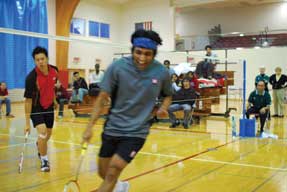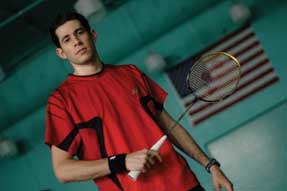Magazine
Smashing Comeback

Immigrants fuel a resurgence of badminton in America.
|
When Ajit Umrani left his career playing badminton for the state of Maharashtra and moved from Pune, India, to Southern Virginia in 2001, he knew he was leaving behind a life of feathers flying at nearly 200 mile per hour, six-hour daily practices, and constant challenges to his mental discipline. He recognized finding a place to play badminton in the U.S. would be tricky, but never guessed his attempts to start a badminton club at his college would be met with months of indifference and empty gyms, or that he would become a nationally ranked table tennis player in the process of finding a badminton substitute. “Coming here nobody appreciated badminton,” lamented Umrani, who is now the number four ranked singles player in America. “I couldn’t pick up any girls by saying ‘Hey,’ I’m a badminton player’.”
Badminton, once popular among Americans in the 1930s-1950s, is being rediscovered thanks primarily to immigrants, many of whom are Indian. Indians consistently rank among the top 10 players in the country, including the top men’s singles player, Raju Rai, who represented the U.S. at the 2008 Beijing games. These new generation of American players is making a mark internationally in a sport long dominated by China, Malaysia, South Korea, Indonesia and Denmark. In 2005 Howard Bach and Tony Gunawan brought the World Champion doubles title to the U.S. for the first time ever. Bach and his new partner, Bob Malaythong, made it to the quarter final round in men’s doubles at the 2008 Beijing Olympics, the best the United States has advanced in the games since badminton became an Olympic sport in 1992. Membership in U.S.A. Badminton is up from 2,700 members in 1995 to 4,000 today. In 2006, in an effort to speed up badminton matches and make them more enjoyable to watch on television, the World Badminton Federation introduced a new rally scoring system. Previously games were played to 15 points and players could only win a point on their serve. Games now go to 21 points and players gain points when their opponent makes a mistake, regardless of who is serving. Although some local clubs and schools are still resistant to the change, badminton clubs are experiencing unprecedented growth nationwide. The San Francisco Bay Area, where four years ago players competed for space in community colleges, now boasts nine clubs. The Northeast is experiencing similar resurgence. While her organization does not maintain official statistics, Beth Sopka, president of Northeast Badminton, estimates that nearly 30 percent of players in the Northeastern U.S. are of Indian descent. The percentage is not as high in other parts of the U.S., where East Asians, Europeans and Americans dominate, according to Sopka.
“In the past five to eight years we’ve a lot more players playing,” said Prakash Gavri, president of Washington, D.C. Badminton. “The places to play have more than doubled in the past few years,” he added, and estimates that 60 percent of the players in his club are of Indian descent. The New York City badminton club started in 1996 with just 10 members now has over 200 players smashing throughout Manhattan and Queens, according to Veronica Wu, co-organizer of NYC Badminton with husband and former Spanish Olympic coach Chibing Wu. Many club players are jumping into local tournament circuits. “More beginners and intermediate players want to play tournaments,” said Wu. “Before it was mostly advanced players who would enter the tournaments.” Participation doubled from 110-130 players two years ago to 240 at the D.C. Open this year, according to Gavri. The Boston Open, likewise, attracted a record 216 participants. “Once I went to a couple of tournaments I realized they’re a lot of fun,” said Hiten Chadha, senior managing consultant at IBM in Fairfax, Virginia. “Above all, the badminton fraternity in India and the U.S. has introduced me to a lot of nice people with different ethnic backgrounds.” Badminton enthusiasts also tout the health benefits of the sport. A statistical comparison between a 1985 World Championship badminton match and an All-England championship tennis calculated the match intensity of each by dividing the time the ball or shuttle was in flight by the length of the match. The analysis found the badminton match had an intensity of 48 percent, more than five times that of the tennis match, which had an intensity of nine percent. “When I went back to India people were impressed that I could climb the seven hills of Tirupati in 1 hour and 40 minutes, while an average person would take more than three hours. The only reason I could do that is because of badminton,” said Srineel Jalagani, a software engineer at Credit Suisse in New York City. “It is double the workout of tennis, double the excitement of soccer, and in half the amount of time.” Chadha agreed: “The sport has given me a good amount of physical fitness. It helped me recover from high blood pressure.” Karishma Kollipara of Illinois, who just graduated from high school and has won three Illinois state championships and a record of 146 wins and one loss in her badminton career, said: “It’s a lot tougher than people think…and you have to make on the spot decisions. It’s a mental game too.” Indian American badminton players say that even in India, where they grew up, badminton was overshadowed by cricket. “There is only one sport in India and that’s cricket,” said Vincent Lobo, who played for India and is now ranked number four in American men’s doubles with Anil Nair. India’s Dipankar Bhattacharya made it to the third round in the 1992 Olympics. At the 2008 Beijing Olympics Saina Nehwal advanced as far as the quarter finals. Currently India has five teams ranked in the top 50 in the world, according to the International Badminton Federation; the United States, by contrast, has three teams in the Top 50.
Indian players hit the world stage after Pullela Gopichand became the second Indian to win the prestigious All England tournament in 2001, after Prakash Padukone, who won the title in 1980. Gopichand was awarded the Rajiv Gandhi Khel Ratna, the highest sports honor in India. “That was the biggest boost for badminton,” recalled Umrani. “When that happened (badminton players) got a mini-celebrity status.” Nevertheless, it is difficult for Indian badminton players to figure out ways to finance their athletic aspirations. Anil Nair remembers when he was faced with a life altering decision: train to make the Indian badminton team, or give up sports completely and study to become a doctor or engineer. He was 16 and had been playing badminton for four years. For him the decision was clear, but his father and uncles strongly disapproved of his choice. “The badminton bug had gotten to me…I decided my biggest goal was to play for India,” said Anil. “It became a burning ambition to prove my dad and uncles wrong.” And he did just that – being selected to play for India two years later and becoming the 1993 mixed doubles national champion with his partner Archana Deodhar. Not everyone can make that choice. The focus on education consumes most young middle class Indians. “I stopped playing when I was 16,” said Karthick Krishnan, who played recreationally in a parking lot near his house in Madras when he was young. He now plays weekly at a club in New York City. Krishnan says his parents would not let him play, even recreationally when he entered the 11th standard: “Everything is about getting a good degree. It’s rare for someone to say ‘pursue your passion,'” said Nair. Those who become international badminton competitors, like Nair’s doubles partner Vincent Lobo, who at one point ranked 35th in the world, usually can’t make a living off the prize money in badminton. When Gopichand won the All England Badminton Championships, the most prestigious badminton tournament, he received $10,000. By contrast, Goran Ivanisevic, who won the all England tennis tournament that same year, was awarded $700,000. In 2008 the total prize purse for the All England Badminton tournament was $200,000; the All England tennis tournament at Wimbledon boasted a prize purse of $23.5 million. Consequently, badminton competitors must find jobs with companies that support their travel and training schedules. “In India no one is a professional,” said Lobo. “No matter what, you can’t live off the prize money.” Nor in the United States either. Kamesh Puthur Loganathan, who played badminton for Tamil Nadu and moved to the U.S. in 2006: “You can figure out for yourself ‘if I win all tournaments in the U.S. this is what I’m going to make, but working in a hedge fund and this is what going to make.’ It’s easy to choose after that.” In 2006 the United States Olympic Committee (USOC) slashed funding for USA Badminton from $1 million to $80,000 when it failed to meet its goals. That has meant some top players were forced to live with their coaches and find jobs to finance their playing. Olympian and 2005 World Champion Howard Bach works at a nearby Home Depot. However, Indian American players are encouraged by the success of players from the community in the U.S. “I thought American badminton was non-existent…(but) there are so many badminton players from India – Sunil (Polineni), Kamesh (Basavaraju), Vincent (Lobo), and Anil (Nair),” said Sarada Jasti, a player for the Indian team who moved to the U.S. to study law at Cornell University in 2007. She was ranked number four in women’s singles in India when she left. Last November she won the Mid-Atlantic Open in Philadelphia, her first tournament since moving to the U.S. Umrani is also able to play badminton again. He recently moved to the Boston area, which has several clubs. In the past year he won the men’s singles at the 2007 Charlotte Open in North Carolina, the 2007 Mid-Atlantic Open in Philadelphia, and the 2008 National Capital Open in Washington D.C. “It’s a rush to go back out and play…. Badminton is one of the most exhilarating sports today,” he says. “It’s a game of wit, power, and skill. A game that really gives you the opportunity to bring out the best in yourself.”
|





